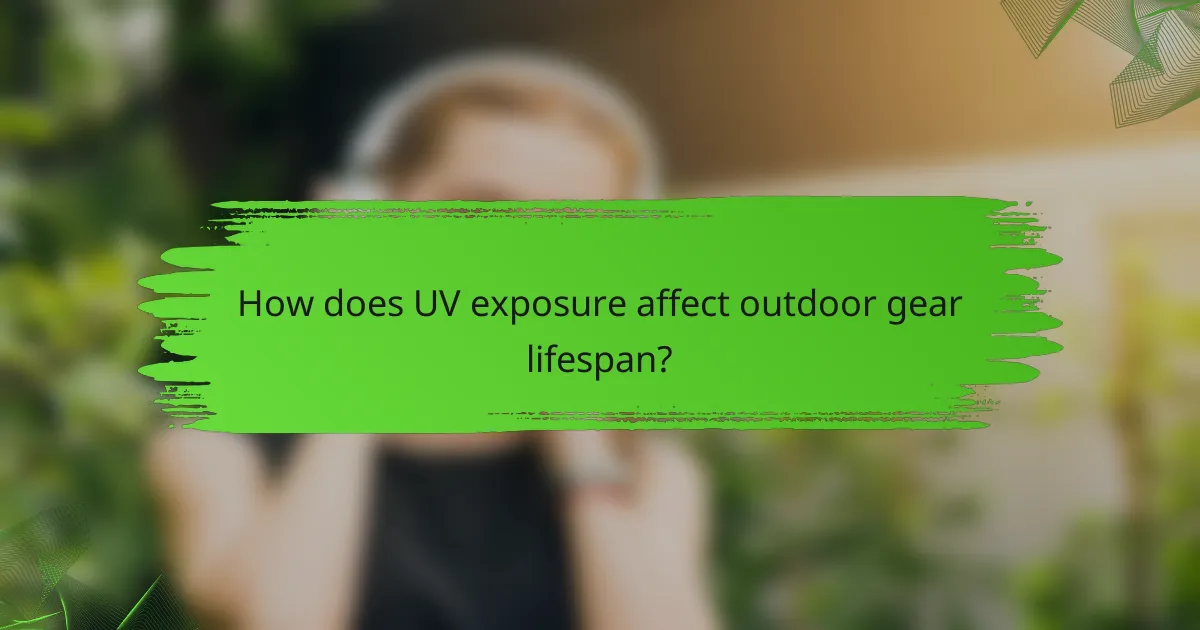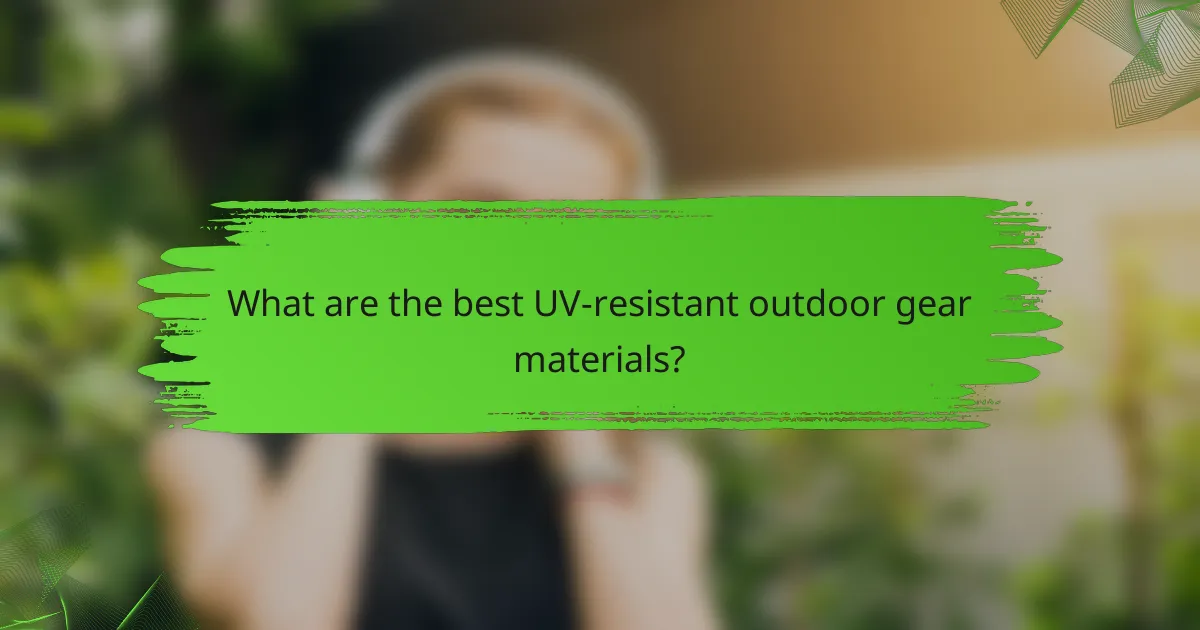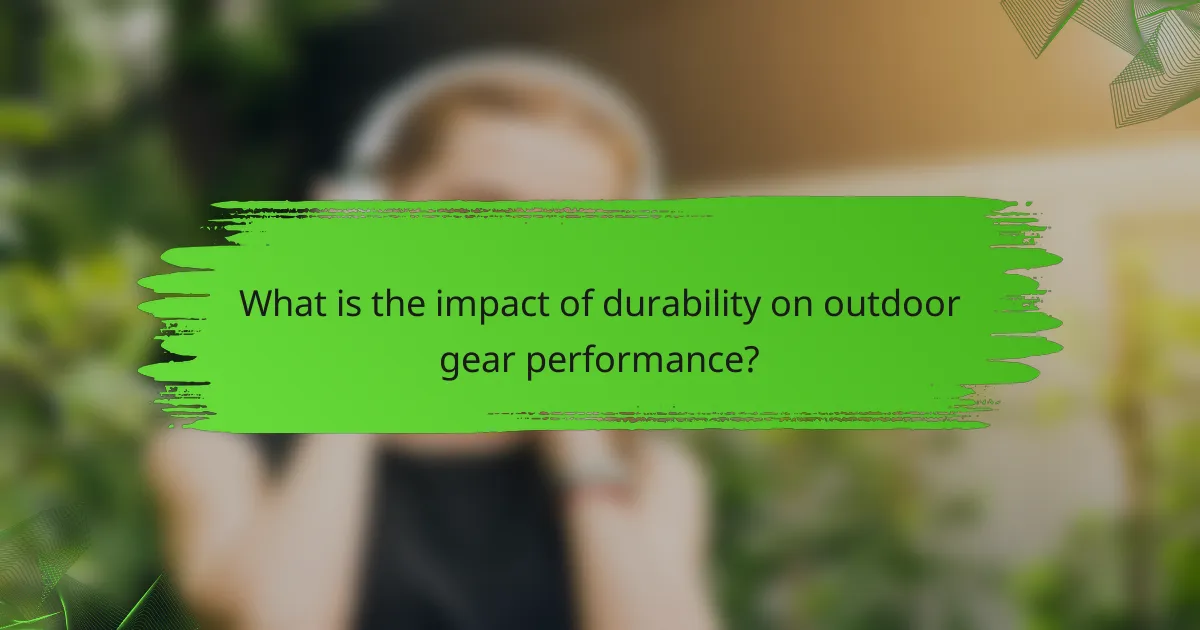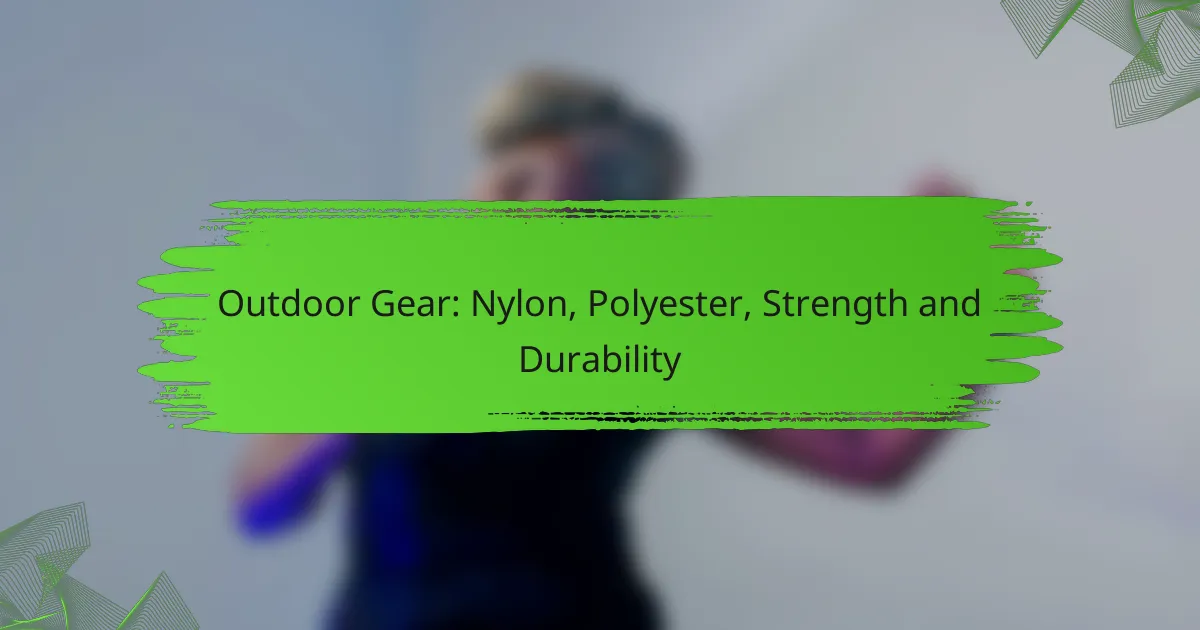Outdoor gear is often exposed to harmful UV rays, which can significantly reduce its lifespan by causing material degradation, color fading, and loss of structural integrity. Choosing UV-resistant materials like polyester and nylon can enhance durability and prolong the life of your equipment. Additionally, employing protective strategies such as UV-blocking sprays and proper storage can help maintain performance and safety in harsh sunlight.

How does UV exposure affect outdoor gear lifespan?
UV exposure significantly reduces the lifespan of outdoor gear by causing various forms of damage. Prolonged sunlight can lead to material degradation, color fading, and loss of structural integrity, all of which can compromise the performance and safety of the equipment.
Material degradation
UV rays can break down the molecular structure of materials used in outdoor gear, such as nylon, polyester, and rubber. This degradation often results in brittleness, cracking, or even complete failure of the material over time. For instance, a tent made from UV-sensitive fabric may last only a few seasons if frequently exposed to direct sunlight.
To mitigate material degradation, consider using gear treated with UV-resistant coatings or fabrics. Regularly storing equipment in shaded areas or using protective covers can also extend its lifespan significantly.
Color fading
Color fading is a common consequence of UV exposure, particularly in brightly colored outdoor gear. The pigments used in fabrics can break down under UV light, leading to a washed-out appearance that not only affects aesthetics but can also reduce visibility and safety in outdoor activities.
To minimize color fading, choose gear made with UV-stable dyes or materials. Additionally, washing gear with UV-protective detergents can help maintain color integrity over time.
Structural integrity loss
As UV exposure continues, the structural integrity of outdoor gear can be compromised. This loss can manifest as weakened seams, reduced tensile strength, or failure of zippers and buckles. For example, a backpack exposed to constant sunlight may experience zipper malfunctions or torn straps, which can be dangerous during outdoor excursions.
To preserve structural integrity, inspect gear regularly for signs of wear and tear, especially after prolonged sun exposure. Storing gear in a cool, dry place when not in use can also help maintain its strength and functionality.

What are the best UV-resistant outdoor gear materials?
The best UV-resistant outdoor gear materials include polyester, nylon, and specialty coatings. These materials offer varying levels of protection against UV rays, enhancing durability and extending the lifespan of outdoor equipment.
Polyester
Polyester is a popular choice for outdoor gear due to its inherent UV resistance. It can block a significant percentage of harmful UV rays, making it suitable for items like tents, backpacks, and clothing. Additionally, polyester is known for its durability and resistance to fading, which helps maintain the appearance and functionality of gear over time.
When selecting polyester gear, look for items labeled with a high UV protection factor (UPF). This rating indicates how effectively the material can shield against UV radiation, with higher values offering better protection. Regular maintenance, such as washing and proper storage, can further enhance the lifespan of polyester gear.
Nylon
Nylon is another widely used material in outdoor gear, known for its strength and lightweight properties. While it does not naturally resist UV rays as well as polyester, many nylon products are treated with UV-blocking agents to improve their performance. This makes nylon suitable for applications like tents, hammocks, and outdoor apparel.
When choosing nylon gear, consider the specific treatment used for UV protection. Some brands offer nylon with enhanced UV resistance, which can significantly extend the life of the product. Regular inspections for wear and tear are essential, as UV exposure can weaken nylon fibers over time.
Specialty coatings
Specialty coatings are applied to various materials to enhance their UV resistance. These coatings can be found on items like tarps, rain jackets, and outdoor furniture, providing an additional layer of protection against sun damage. Common coatings include polyurethane and silicone, which help repel water and resist UV degradation.
When selecting gear with specialty coatings, check for the manufacturer’s specifications regarding UV protection and durability. Regular cleaning and reapplication of coatings may be necessary to maintain their effectiveness. Be aware that while coatings can enhance performance, they may also affect breathability and comfort, so choose wisely based on your specific outdoor activities.

How can I protect my outdoor gear from UV damage?
To protect outdoor gear from UV damage, consider using UV-blocking sprays, proper storage techniques, and selecting UV-resistant products. These strategies can significantly extend the lifespan of your gear and maintain its performance in harsh sunlight.
Use UV-blocking sprays
UV-blocking sprays are designed to create a protective layer on your outdoor gear, shielding it from harmful ultraviolet rays. These sprays can be applied to various materials, including fabrics, plastics, and leathers, and are often water-resistant as well.
When using these sprays, ensure that the surface is clean and dry before application. Follow the manufacturer’s instructions for optimal results, typically allowing the spray to dry completely before exposing the gear to sunlight.
Store gear properly
Proper storage is crucial for minimizing UV exposure to your outdoor gear. Store items in a cool, dry place away from direct sunlight, such as a closet or storage bin. If outdoor gear must be kept in a garage or shed, consider using UV-blocking covers or tarps.
Additionally, avoid folding or compressing gear in a way that could damage its structure. Instead, hang items when possible, as this helps maintain their shape and integrity over time.
Choose UV-resistant products
Selecting UV-resistant products is one of the most effective ways to prevent UV damage. Look for gear that explicitly states it has UV protection, often indicated by a UPF (Ultraviolet Protection Factor) rating. Products with a UPF of 30 or higher are generally considered good options.
When shopping, consider the materials used in the gear. Synthetic fibers like nylon and polyester often provide better UV resistance compared to natural fibers. Investing in high-quality, UV-resistant gear may have a higher upfront cost but can save money in the long run by reducing the need for replacements.

What is the impact of durability on outdoor gear performance?
Durability significantly affects outdoor gear performance by determining how well the equipment withstands environmental stressors and wear over time. High durability often translates to better performance, as gear that can endure harsh conditions tends to last longer and function effectively.
Longer usability
Durable outdoor gear typically offers longer usability, meaning it can withstand repeated use without significant degradation. For instance, a high-quality tent made from robust materials can last several seasons, while a cheaper alternative may only endure a few trips. Investing in durable gear can save you from frequent replacements and enhance your outdoor experiences.
When selecting gear, consider materials like ripstop nylon or heavy-duty polyester, which are known for their longevity. Look for products with warranties that reflect their expected lifespan, as this can be a good indicator of durability.
Cost-effectiveness
Durability contributes to cost-effectiveness by reducing the need for frequent purchases. While high-quality outdoor gear may have a higher upfront cost, its longevity often results in lower overall expenses. For example, a durable pair of hiking boots may cost more initially but can last years, whereas cheaper options might require replacement every season.
To maximize cost-effectiveness, evaluate the total cost of ownership, which includes purchase price, maintenance, and replacement frequency. Opt for gear that balances quality and price, ensuring you get the best value for your investment.
Safety during use
Durable outdoor gear enhances safety during use by minimizing the risk of equipment failure in critical situations. For example, a sturdy climbing harness made from high-strength materials is less likely to break under stress, providing peace of mind while engaging in high-risk activities. In contrast, less durable gear may compromise safety, especially in challenging environments.
Always check for safety certifications and user reviews when purchasing outdoor gear. Look for products that meet industry standards, as these are often designed with durability and safety in mind, ensuring they perform well under pressure.

What factors influence the durability of outdoor gear?
The durability of outdoor gear is primarily influenced by material quality, manufacturing processes, and environmental conditions. Understanding these factors can help consumers choose gear that lasts longer and withstands the rigors of outdoor activities.
Material quality
The type of materials used in outdoor gear significantly impacts its durability. High-quality fabrics, such as ripstop nylon or polyester, offer better resistance to wear and tear compared to lower-grade options. Additionally, materials treated for UV resistance can help prevent degradation from sun exposure.
When selecting gear, look for products that specify their material composition and any protective treatments. For instance, gear made with Gore-Tex or similar waterproof membranes tends to have a longer lifespan due to their durability and resistance to environmental factors.
Manufacturing processes
The manufacturing processes employed in producing outdoor gear can greatly affect its overall strength and longevity. Techniques such as double stitching and reinforced seams enhance durability, while poor construction can lead to premature failure. Brands that adhere to strict quality control standards typically produce more reliable products.
It’s beneficial to research brands known for their craftsmanship. Look for certifications or reviews that highlight the manufacturing quality, as this can be a strong indicator of how well the gear will hold up over time.
Environmental conditions
Outdoor gear is often subjected to various environmental conditions that can impact its durability. Factors such as exposure to UV rays, moisture, and extreme temperatures can accelerate wear. For example, gear frequently used in sunny climates may require UV-resistant materials to prevent fading and degradation.
To extend the lifespan of your gear, store it properly when not in use. Avoid leaving items in direct sunlight for prolonged periods and ensure they are dry before storage to prevent mold and mildew. Regular maintenance, such as cleaning and reproofing, can also help gear withstand harsh conditions better.

How do I choose durable outdoor gear?
Choosing durable outdoor gear involves assessing materials, construction quality, and suitability for specific activities. Look for gear that balances weight, strength, and resistance to environmental factors like UV exposure and moisture.
Consider Material Quality
Material quality is crucial for durability. Look for fabrics like nylon or polyester, which offer good resistance to wear and tear. Additionally, check for water-resistant coatings or treatments that enhance longevity in wet conditions.
For hard goods, such as tents or backpacks, materials like aluminum or high-density polyethylene provide strength without adding excessive weight. Always consider the intended use; heavier materials may be acceptable for base camp gear, while ultralight options are better for backpacking.
Evaluate Construction Techniques
The construction techniques used in outdoor gear significantly impact its durability. Look for reinforced seams, double stitching, and quality zippers that can withstand frequent use. Brands that offer a warranty often stand behind their craftsmanship.
Pay attention to the details, such as the type of stitching used. For instance, bar-tack stitching at stress points can prevent ripping and extend the gear’s lifespan. Always inspect gear before purchase for signs of poor construction.
Assess UV Resistance
UV resistance is vital for outdoor gear exposed to sunlight. Fabrics treated with UV inhibitors can prevent degradation and fading, which is essential for items like tents, tarps, and clothing. Look for gear with a high Ultraviolet Protection Factor (UPF) rating.
Consider the duration of exposure when selecting gear. If you plan to spend extended periods outdoors, prioritize items with enhanced UV protection. This is especially important in regions with high sun exposure, such as coastal areas or high altitudes.
Check for Maintenance and Repair Options
Durability is not just about initial quality; it’s also about maintenance and repair. Choose gear that is easy to clean and maintain, as this can significantly extend its life. Some brands offer repair kits or services, which can be a valuable resource.
Familiarize yourself with common repair techniques, such as patching holes or re-sealing seams. Knowing how to perform basic repairs can save you money and keep your gear functional for longer. Always check if the manufacturer provides support for repairs and replacement parts.



